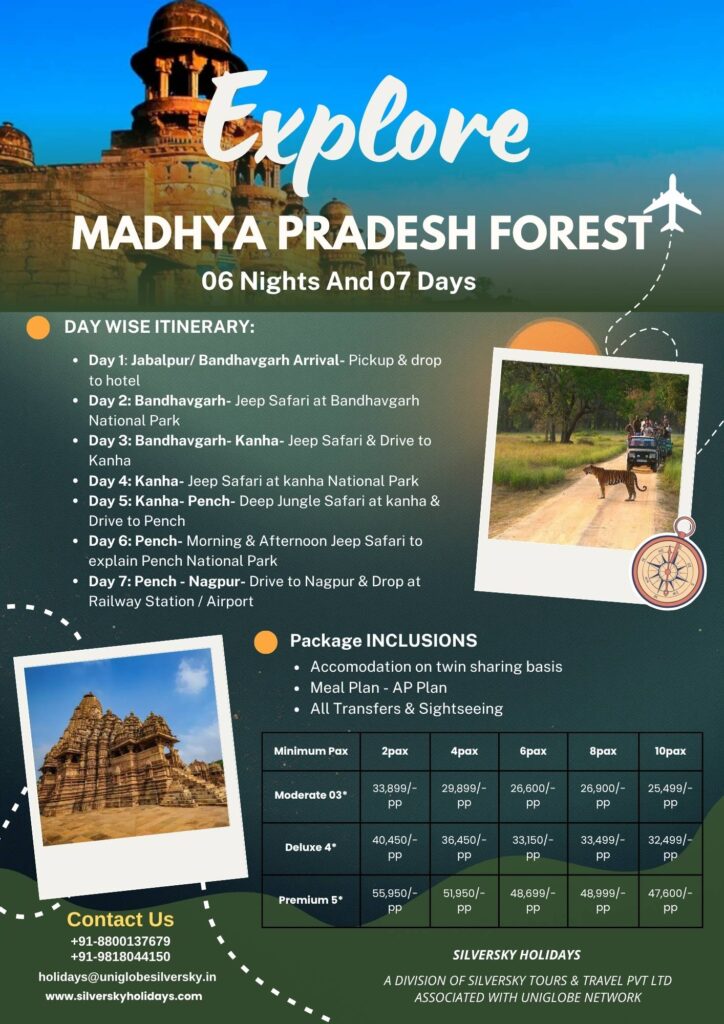There is a specific moment on an Indian safari that you never forget. It’s not necessarily the moment you see the tiger. It’s the moment the engine cuts. The guide raises a hand, signaling absolute silence. The forest, which seemed chaotic a minute ago, suddenly feels heavy with anticipation. A langur monkey gives a sharp alarm call from the canopy. A deer freezes, looking in one direction.
You hold your breath.
While Africa often dominates the global conversation about safaris, India offers something entirely different. It is dense, mysterious, and vibrant. It is the land of The Jungle Book, where ancient ruins hide inside tiger reserves and leopards coexist with shepherds on rocky outcrops.
If you are planning your travels for 2026, India’s national parks should be high on your list. However, navigating the booking systems, zones, and seasons can be complex. This guide breaks down the top wildlife experiences across the subcontinent, what to expect on the ground, and how to plan a trip that balances adventure with comfort.
What to Expect: The Reality of an Indian Safari
Before we look at where to go, let’s talk about how it works. Unlike the private conservancies in Africa where you might drive off-road, Indian national parks are government-regulated.
The Vehicles: You will typically travel in a Gypsy (a small 4×4 jeep, usually open-top) or a Canter (an open bus seating 16-20 people).
Tip: Always push for the Gypsy. It offers better visibility, maneuvers faster, and allows you to stop for photos without needing a committee vote from 18 other passengers.
The Zones: Parks are divided into tourism zones. Not all zones are created equal. Some have higher animal density. Others are more scenic but quieter on the wildlife front.
Indian jungles are thick. You rarely see animals standing on open plains for miles (except perhaps in parts of Kaziranga). Tracking here relies on listening to alarm calls and reading pugmarks. It is an active, engaging hunt for sightings.
Jim Corbett, Uttarakhand: The Old Guard
Established in 1936, this is India’s oldest national park. Located in the foothills of the Himalayas, Corbett isn’t just about wildlife; it is arguably one of the most beautiful landscapes in the country—riverbeds, hills, and grasslands (Chaurs).
The Experience
Corbett is famous for its tigers, but it is also an incredible bird-watching destination. The park is massive, divided into several zones. The Dhikala Zone is the most coveted. It is located deep inside the forest, and it’s one of the few places in India where you can stay overnight within the core park area in forest rest houses. Waking up to the sound of elephants trumpeting across the Ramganga river is an experience hard to beat.
Best For: Serious wildlife enthusiasts, photographers, and those who want the thrill of staying inside the jungle.
Key Insight: Because it is close to Delhi, it gets busy on weekends. Aim for a weekday visit if possible.

Ranthambore & Jawai, Rajasthan: Royalty and Rocks
Rajasthan offers a stark contrast to the green hills of Corbett. Here, the jungle is dry, dusty, and gold—providing excellent visibility for spotting predators.
Ranthambore National Park
This is perhaps the most famous tiger reserve in the world. The backdrop here is dramatic: the 10th-century Ranthambore Fort towers over the park, and old ruins are scattered throughout the forest. Seeing a tiger lounging in the archway of an ancient palace is a quintessential Ranthambore moment.
- Zones: Zones 1-5 are considered “core” and generally offer better sightings than 6-10.
- Logistics: It is easily accessible from Jaipur, making it a perfect addition to a cultural trip.
Jawai: The Land of Leopards
If you want something offbeat for 2026, head to Jawai. It isn’t a national park in the traditional sense; it’s a landscape of massive granite hills where leopards live freely alongside local villagers.
- Why go? In most parks, leopards are shy and hide from tigers. In Jawai, they are the apex predators. You don’t just get a glimpse; you often watch them for hours on the rocks.
- Cultural Nuance: The Rabari herdsmen here, with their red turbans, have lived in harmony with these big cats for over a century. It’s a fascinating case study in coexistence.
You can easily combine these parks with our Rajasthan tour packages, blending palace stays in Udaipur with jungle drives.
Kaziranga, Assam: The Land of Giants
Travel east, and the landscape shifts to the floodplains of the Brahmaputra River. Kaziranga is a success story of conservation, hosting two-thirds of the world’s great one-horned rhinoceroses.
The Experience
Unlike the thick canopy of central India, Kaziranga is defined by tall elephant grass (which can hide a full-grown elephant) and vast wetlands.
- The Big Five: Kaziranga is home to the Rhino, Tiger, Elephant, Wild Water Buffalo, and Swamp Deer.
- Elephant Safari: This is one of the few places where an elephant safari is still a viable and regulated way to see wildlife, as the elephants can navigate the marshy grassland where jeeps cannot go. It allows you to get surprisingly close to the rhinos without disturbing them.
Best For: Travelers looking for something distinct from the “standard” tiger safari.
Exploring the Northeast requires good logistics. Check our Northeast tours for itineraries that handle the permits and transport in this region.
Kanha & Pench, Madhya Pradesh: The Jungle Book Realized
If you grew up reading Kipling (Mowgli & Jungle Book), this is the setting. Madhya Pradesh (MP) is known as the “Tiger State of India,” and for good reason.
Kanha National Park
Kanha is vast and lush, with Sal forests and large meadows (maidans). It is the only place where you can see the Hard Ground Barasingha (swamp deer), which was brought back from the brink of extinction here. The tracking skills of the guides in MP are legendary.
Pench National Park
Pench is contiguous with Kanha and offers similar terrain but often with fewer crowds. It is excellent for spotting wild dogs (Dholes) and large herds of Gaur (Indian Bison).

Why combine them?
A road trip between Pench and Kanha takes you through rural India, offering a look at village life that you miss when flying. It’s a “Jungle Corridor” drive that many enthusiasts swear by.
Gir, Gujarat: The Last Pride
You cannot find Asiatic Lions anywhere else in the wild—not even in Africa (where you find African lions). Gir is their only home.
The Experience
The terrain here is rugged, scrubby, and dry. Lions are generally more social and less elusive than tigers, meaning if you find a pride, you might spend a good amount of time watching them interact, play, or sleep.
Tip: Combine this with a visit to Somnath or Diu. Gujarat has excellent roads, making road trips comfortable.
Periyar, Kerala: The Gentle Wilderness
Periyar Tiger Reserve in Thekkady offers a completely different vibe. While tigers are present, they are elusive. You come here for the elephants and the birds.
The Experience
The primary way to view wildlife here is by boat on the Periyar Lake. You drift slowly, watching herds of elephants come to the water’s edge to drink and bathe. It is relaxed and scenic, a great option for families with young children or seniors who might find the bumpy jeep rides of other parks exhausting.
Activity: Periyar also allows guided nature walks and bamboo rafting, which are rare in other tiger reserves due to safety concerns.
A visit here fits perfectly into a broader itinerary covering Munnar and Alleppey. See our Kerala tour packages for route ideas.
Practicalities: Planning Your 2026 Safari
Safari planning in India is competitive. The best zones and the limited number of jeep permits sell out months in advance. Here is how to navigate it.
Best Time to Visit
- October to March: The weather is pleasant (cold mornings, warm days). The forest is green and lush immediately after the monsoon. This is the most comfortable time for travelers.
- April to June: This is the Indian summer. It gets hot—often over 40°C (104°F). However, as water sources dry up, animals are forced to come to the remaining waterholes. This is the best time for tiger sightings.
- July to September: Monsoon. Most parks (like Corbett and Ranthambore) close their core zones. However, buffer zones in some parks and Periyar in Kerala remain open.
Estimated Costs (Per Safari)
Safari pricing in India has a two-tier system (Indian Nationals vs. Foreign Nationals). Prices also vary depending on whether you book the entire jeep (highly recommended) or a single seat.
- Economy (Canter/Shared Seat): starting approx ₹3,000 per person.
- Premium (Exclusive Jeep): Roughly ₹7,000 – ₹14,000 per jeep (varies by park).
- Luxury Lodges: Accommodation ranges from ₹10,000 to over ₹60,000 per night for high-end brands like Taj or Oberoi.
What to Pack
- Layers: Jungle mornings in open jeeps are freezing, even in March. Wear a fleece jacket that you can peel off as the sun rises.
- Neutral Colors: Wear browns, greens, and beiges. Bright red or neon blue scares the wildlife and annoys serious photographers.
- Dust Protection: A scarf or buff is essential, especially in dry parks like Ranthambore and Gir.
- Binoculars: Do not rely on the guide’s pair. Having your own changes the experience.
How SilverSky Holidays Adds Value
We often hear travelers say, “I tried to book the safari online, but the website crashed/zones were full/I didn’t know which gate to pick.”
This is where we step in.
At SilverSky Holidays, we treat safaris as a specialized experience, not just a ticket booking.
- Permit Management: We track the opening dates for permits (often 60 to 90 days in advance) and have our teams ready to book the prime zones the minute they open.
- The Right Drivers: In the jungle, the driver and naturalist make or break the trip. We request seasoned drivers who know how to position the vehicle for the best angle without harassing the animal.
- Cultural Context: We ensure your trip isn’t just “airport-hotel-safari-airport.” We integrate village walks, local culinary experiences, and heritage stays so you understand the community that lives on the fringe of the forest.
Ready for the Wild?
India’s jungles are unpredictable. You might go for three drives and see nothing but deer, and then, on your fourth drive, watch a tigress walk her cubs across the road ten feet away from you. That unpredictability is magic.
Whether you want to track rhinos in the tall grass of Assam or watch leopards on the granite hills of Jawai, 2026 is the year to make it happen.
If you are unsure which park fits your month of travel or your group’s physical ability, reach out to us. We love talking wildlife. Explore our packages or drop us a message to build a custom itinerary. The jungle is waiting.

